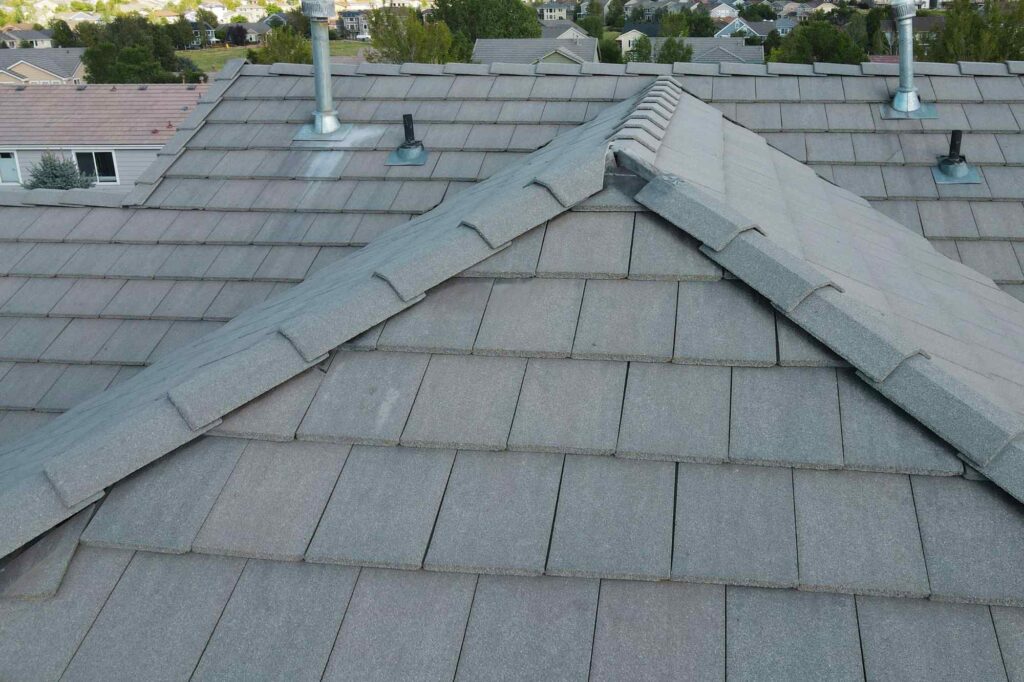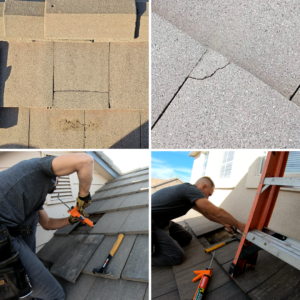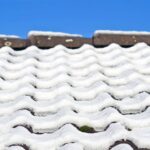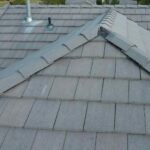
Hail damage on tile roofs is something Aurora homeowners have to deal with from time to time, but especially so when the Colorado hail season begins. Throughout mid April to mid September, these hailstorms can be frequent and at times destructive.
While tile roofing is one of the most durable types of roofing available, the forceful impact from hail can still cause cracks, breaks, and all sorts of damages. Hail damage on a tile roof can manifest in various ways, and being able to recognize these signs is essential for timely repairs.
In this guide, we’ll discuss the effects of hail damage on tile roofs, explore the long-term consequences of untreated damage, and provide expert tips on how to identify and deal with tile roofing hail damage. Let’s begin!
Understanding Hail Damage on Tile Roofs
Can hail damage a tile roof? It most certainly can. Tile roofs are tough and long-lasting, but that doesn’t mean they’re invincible. Like any other roofing material, they can crack and break from the impact and size of the hail, especially if there are frequent or consecutive storms.
Additionally, hailstones come in a variety of sizes, with the larger ones (the size of baseballs or grapefruits!) dealing more damage. Apart from the size, hail can also hit your roof at speeds up to 100 MPH or more.
So when a hailstorm comes and passes, it’s not surprising if it leaves damages on your tile roofing. In fact, studies show that even hail as small as 1-1/4″ diameter can cause damage on some tile roofs, depending on the impact.
Longer and more severe storms with larger hailstones can cause more significant damage to the roof. Moreover, clay tiles are more susceptible to damage than concrete ones, while substandard construction increases the roof’s vulnerability.
Signs of Hail Damage on Tile Roofs
Identifying tile roof hail damage can be challenging, as it may not always be obvious at first glance. However, there are certain telltale signs of hail damage on tile roofs that homeowners should look out for:

- Chips, cracks, and breaks: Upon close inspection, you may notice numerous chips and cracks on individual tiles or larger portions. The severity of the damage depends on the size and force of the hailstones. Rounded cracks on the edges is a common sign of hail damage on tile roofs.
- Loose or dislodged tiles: High-speed hailstones can dislodge tiles, causing them to become loose or even fall off the roof. This can leave your roof vulnerable to leaks and further damage.
- Loss of color: Hailstones can cause the protective coating on tiles to wear off, resulting in a loss of color and a shabby appearance.
- Spalling and deterioration: Over time, hail damage can lead to micro-fractures and chips in the tiles. You can spot spalling on concrete tiles— this is when the concrete breaks off in fragments. These imperfections may not be immediately visible but can worsen over time, compromising the integrity of the roof.
Long-term Consequences of Hail Damage on Tile Roofs
Hail damage on a tile roof goes beyond issues with visual or aesthetic appearance. It can have a significant impact on the structure and integrity of the roof, as well as many other consequences.
- Increased costs: Initially, hail damage on tile roofs may seem superficial, but it can progress to more severe issues, such as leaks and structural damage. Delaying repairs can result in higher costs in the long run.
- Accumulation of debris: Hailstorms can leave behind debris and chipped tiles, which can accumulate in gutters and disrupt proper drainage. This can lead to additional problems, such as water damage and clogged gutters.
- Temperature changes: As hail-damaged tiles deteriorate, they become less energy efficient and more susceptible to temperature fluctuations. Additionally, moisture can seep into the cracks and freeze during winter, causing further damage and compromising the roof’s integrity.
- Unrepaired cracks: If cracks and chips are not promptly repaired, they can worsen over time, leading to more leaks and water damage. This can result in rotting wood, mold growth, and electrical problems.
- Damaged felt underlayment: A broken roof tile can’t properly protect the felt underneath, which is the waterproofing barrier of your tile roofing. Once the felt underlayment gets damaged or is infiltrated by water, it can lead to water and structural damage.
Hail Damage on Tile Roofs: Tips on What to Do After a Hailstorm
After a hailstorm, it’s essential to take action to assess and repair any damage to your tile roof. Here are some expert tips to follow:
Tip #1: Conduct an Inspection
Start by conducting a visual inspection from the ground and look for any visible signs of hail damage on tile roofs, such as cracked or broken tiles. However, for an even more accurate assessment, a closer look at your roof is recommended.
For accuracy, expertise, and safety purposes, seek the assistance of roofers specializing in tile roofing to conduct a roof inspection. They will assess the condition of your roof and point out all signs of damage, big or small.
Tip #2: Document the Damage
Take photographs or videos of the hail damage as evidence for insurance purposes. This documentation can help support your insurance claim, providing concrete visual evidence of the extent of the damage, and ensure that you receive proper compensation for the repairs.
Tip #3: Apply Repairs ASAP
Repairing any hail damage on tile roofs as soon as possible is essential to help keep the damage from worsening as well as avoiding possible water infiltration and further structural damage. If you have the tools, skills, and experience, you can opt for DIY tile roof repairs for minor damages.
However, if you are inexperienced with roof repairs or are dealing with major damages, relying on a professional roofing contractor to deal with repairs is the best option.
Tip #4: Practice Regular Maintenance
After the repairs, it is essential to maintain your tile roof properly. Schedule regular inspections and stay on top of necessary upkeep. This practice can help identify any potential issues and prevent future damage.
By investing in routine care, you are extending your roof’s lifespan and protecting its durability.
Tip#5: Get the Help of a Professional Roofer Near You
For reliable repairs and skillful handwork, hiring a professional tile roof repair service in Aurora, Colorado, saves you from all the hassle and gives you peace of mind.
A professional roofing contractor will be able to replace any damaged tiles and address any underlying issues caused by the hailstorm.
Tile Roof Hail Damage Preventive Measures
While it is impossible to prevent hailstorms, there are some preventive measures you can take to minimize the impact hail damage on tile roofs:
- Choose high-quality materials: Invest in high-quality, impact-resistant tiles that are designed to withstand hail damage. Consult with a roofing professional to determine the best options for your specific climate and location.
- Trim trees and remove debris: Trim any overhanging branches near your roof to minimize the risk of tree damage during hailstorms. Regularly remove debris from gutters and roof surfaces to ensure proper drainage.
- Consider protective coatings: Some protective coatings can provide an extra layer of defense against hail damage. Consult with a roofing professional to determine if a protective coating is suitable for your tile roof.
Tile Roof Repair and Restoration
Timely repair of hail damage on tile roofs is crucial for the long-term health of the roof. Ignoring or delaying repairs can lead to more extensive damage and costly repairs down the line. Water infiltration through cracked tiles can cause rotting of the underlying structure, compromising the overall stability of the roof.
Additionally, dislodged tiles create weak points that can be further damaged during strong winds and storms. By addressing hail damage promptly, homeowners can ensure the longevity of their tile roofs and avoid more significant problems in the future.
Bjorn’s Roofing: Trusted Tile Roofers in Aurora, CO
If you suspect hail damage on your tile roof, don’t delay in taking action. Contact Bjorn’s Roofing for expert tile roof repair in Aurora, Colorado. We also offer FREE roof inspections!
Latest Posts
Related: tile roof hail damage, hail damage on tile roofs, concrete tile roofs, tile roof repair aurora, tile roofing hail damage



